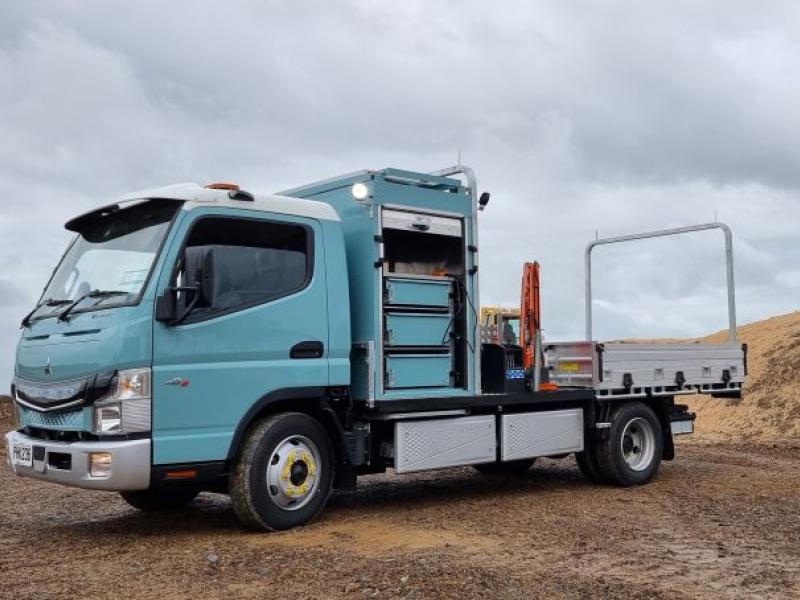Mitsubishi has revealed its new Triton ute – and Company Vehicle was represented by two out of only three journalists given an exclusive pre-launch preview, including an extensive ride and drive which included both on and off-road conditions. John Oxley reports.
The new Mitsubishi Triton has hit the road running. That’s quite clear after we drove the vehicle in and around Wellington, and after detail examination of its credentials with Mitsubishi’s marketing, sales and engineering teams.
Built new from the ground up, quashing rumours that it’s just a big facelift (no, the old body won’t fit on the new chassis, and vice versa, although wheelbase and track are the same measurements), the latest Triton features wide use of hot pressed high tensile steel, resulting in a body shell that is stronger, lighter, and more rigid,
Although evolutionary in its design language, the latest body is much more modern, with strong side creases each side, and a powerful front end featuring a big chromed grille. On the top-end GLS model this is flanked by modern HID projector lights with LED daytime running lights, while the “working” GLX model gets halogen.
In terms of its ride and handling, the new model is quite carlike, and we were very impressed by its taut roadholding and comfortable ride. Without testing them side-by-side I’d be reluctant to say if it’s better than the class-leading VW Amarok, but it has to be close.
This latest Triton also gets a new 2.4-litre intercooled turbo-diesel engine and new gearboxes to match its new bodywork, and it’s packed with features, with all models, including the 2WD “tradie” models coming in with Bluetooth handsfree phone connection and a music system, with voice activation and steering wheel controls, plus cruise control, while the new club cab (with double doors) and double cab versions have a 6inch touch screen with radio, CD, MP3, and USB, while double cab versions also get a reversing camera.
GLS models also get features normally found in cars, including rain sensing wipers, light sensing headlamps, pPush button start with KOS, paddle shift, and dual stage aircon.
All models are equipped with electronic stability systems, including a trailer stability system, and every model in the range has been built to 5-star ANCAP standard, with seven airbags on the double cab and club cab models and three on the single cabs – although they have not yet been tested.
All Tritons also come with child seat tethers; one on single cab and two ISOFix on the rest of the range.
Using high strength steel has also enabled the Triton engineers to keep the weight down, and although the new version is 35kg heavier than the old one, the extra power and torque (135kW/437Nm – the latter with 90 percent available from 1,500rpm) means torque to weight ratio is on a par with the current market-leading Mazda BT-50, and on power-to-weight ratio on par with the current joint second, the Ford Ranger and the Nissan Navara.
Fuel economy is a big plus point with the new models, and the claimed figures are excellent, with 7L/100km overall on the 2WD manual, and 7.6L/100km on the 4WD auto. Both manual and auto models have the same torque output.
The Triton comes with a towing capacity of 3,100kg, and although not the best in class, its total payload including trailer eclipses all the opposition because of its lighter weight.
But that’s not all. The Triton comes with a totally new interior which is cheery and car-like, while total leg space, front and rear, is claimed to be best in class, the latter helped by the ability of rear seat passengers to fit their feet under the front seats.
In terms of the gearboxes, sporty drivers will feel at home in the top-end GLS models, which get steering wheel paddles to manually change gears in the Pajero-derived five-speed auto gearbox, while manual models benefit from a low crawl gear in the six-speed ‘box.
And finally, although overall length of the Triton has been shortened compared to the old model – by cutting down on some of the overhang – there’s 10 percent more volume in the wellside, with less wheel arch intrusion. Inside dimensions are 1,520mm long, 1,470mm wide, 475mm high, and 1,085mm between the wheel arches, enough room to place a Euro pallet.
Two drive trains are used in the 4WD models. The GLX and GLX-R have Easy Select4, with changes between high and low ranges now via a rotary dial, while the GLS versions get the Pajero Super Select4-II, with a separate and locking centre differential. All models feature change-on-the-fly between 2WD and 4WD high at speeds up to 100km/h, while the GLS versions can be driven on tarmac in 4WD for safer towing or in inclement conditions, without any windup, thanks to the centre diff.
Range and prices
2WD diesel:
GLX single cab chassis manual $34,790; GLXR double cab manual $45,120;GLXR double cab auto $47,120
4WD diesel:
GLX single cab chassis manual $44,190; GLX Club Cab chassis manual $45,190;GLX double cab chassis manual $46,490 GLX double cab manual $51,990; GLX Double cab auto $53,990; GLS double cab manual $57,490; GLS double cab auto $59,490.






